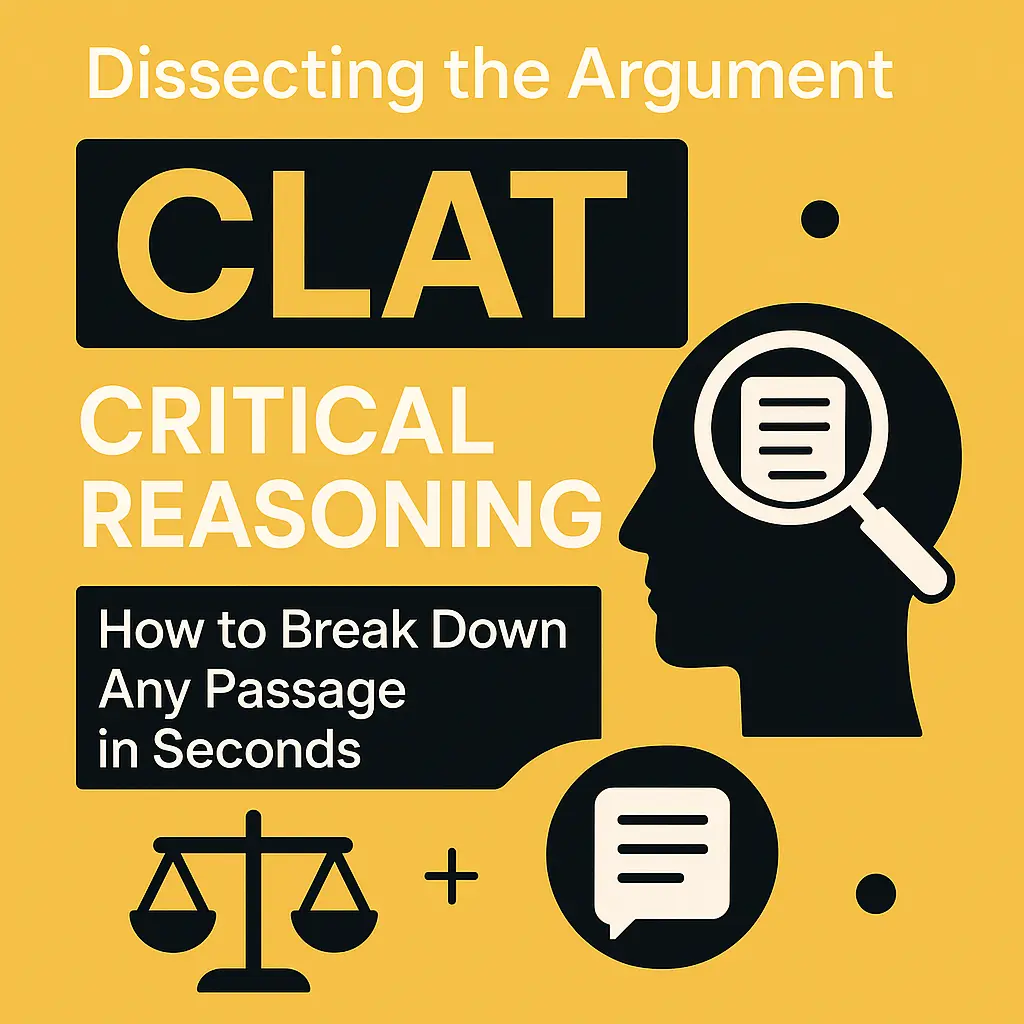
Hey future NLU‑ites!
If Critical Reasoning passages still look like a brick wall, this guide will teach you the art of dissecting the argument CLAT ‑style—so precisely that you’ll start seeing the author’s wiring diagram in under half a minute.
Big promise: Master the framework below, and you’ll save 8‑10 valuable minutes in the Logical Reasoning section—often the difference between a top‑70 and a top‑700 rank.
1. What “Dissecting the Argument” Really Means
At its core, dissecting the argument is a CSI‑style autopsy of any passage. Instead of getting lost in the prose, you separate:
- Conclusion – the claim the author wants you to buy.
- Premises – stated evidence.
- Assumptions – unstated bridges.
- Interjections – qualifiers, examples, counter‑points.
Do this once, and every strengthen/weaken/inference question feels like you already know the ending.
You’ll see me repeat the phrase Dissecting the Argument CLAT often; that’s intentional—breathe it in, because this skill will anchor your Logical Reasoning prep.
2. Why It Matters for CLAT 2026
The Consortium’s blueprint since 2020 rewards micro‑analysis over mugging up facts. With the CLAT 2026 exam expected on 7 December 2025 (first Sunday of December) Careers360 Law, the section is likely to carry 28–30 marks of CR. Students who practice Dissecting the Argument CLAT passages consistently clock >90 percentile accuracy.
2024 data point: The top‑100 scorers averaged just 46 seconds per CR question because they instantly isolated the conclusion, then matched answer choices to premises.
3. The 30‑Second Dissection Framework
| Stopwatch | Action | Typical Markers | Why It Works |
|---|---|---|---|
| 0‑10 s | Locate the conclusion | Therefore, thus, hence, so, clearly | CLAT questions almost always ask about this |
| 11‑18 s | Underline premises | because, since, evidence shows, according to | Prevents “answer‑choice hypnosis” |
| 19‑23 s | Surface assumptions | Gaps between premise & conclusion | Perfect fodder for weaken/strengthen |
| 24‑28 s | Scan qualifiers | most, some, often, unless, however | Spot scope shifts |
| 29‑30 s | Predict answer type | strengthen / weaken / inference / parallel | Walk into options with a filter |
Print this table and tape it on your study desk; use it for every single drill.
4. Live Demo: Break Down a Passage in Real Time
Passage (abridged):
“Urban bike‑sharing schemes reduce traffic congestion because they decrease private‑car usage.”
Quick dissection (you talk through it as you read):
- Conclusion: Bike‑sharing reduces congestion.
- Premise: It decreases private‑car usage.
- Assumption: Lower car usage actually leads to lower congestion (not true if cars simply circulate elsewhere).
- Qualifier check: None—direct cause‑effect.
If the question asks, “Which option most weakens the argument?”—you already know an answer that severs the assumption, e.g., “Congestion in participating cities remained unchanged because delivery‑vehicle traffic rose.”
Repeat this ritual, and every CR passage starts feeling like déjà vu.
5. Five Common Question Types & Your Go‑To Move
| Question Type | Your First Task | Time‑saving Cue |
|---|---|---|
| Strengthen | Attack the biggest assumption | “Which of the following would most support…” |
| Weaken | Supply a counter‑example | “undermines” / “casts doubt” |
| Inference | Chain premises only | “can be concluded” |
| Flaw | Name the assumption gap | “vulnerable because…” |
| Parallel Reasoning | Map structure, ignore topic | “pattern of reasoning most similar” |
Notice how the solution always circles back to Dissecting the Argument CLAT style: conclusion‑premise‑assumption.
6. Speed‑Drill Routine (15 Minutes a Day)
- Warm‑up (3 min): Pick one editorial paragraph from today’s The Hindu. Highlight conclusion & premises.
- Timed Set (7 min): Attempt 5 CLAT‑style CR questions from past papers.
- Error Log (3 min): Note why you missed. Usually, you skipped the assumption step.
- Flash Review (2 min): Recite the 30‑second checklist aloud.
Do this six days a week for 12 weeks, and dissecting becomes muscle memory.
7. Important Dates & Planner
| Event | CLAT 2026 (Tentative) | Past Benchmark (CLAT 2025) |
|---|---|---|
| Notification | July 2025 | 15 Jul 2024 Consortium of NLUs |
| Registration Window | Jul–Oct 2025 | 15 Jul–22 Oct 2024 |
| Exam Date | 7 Dec 2025 (expected) Careers360 Law | 1 Dec 2024 |
| Admit Card | Nov 2025 | 15 Nov 2024 |
| Result | Mid‑Dec 2025 | 10 Dec 2024 |
Block these on Google Calendar right now—no kidding.
8. Where to Practise (Free + Paid)
| Resource | What You Get | Link |
|---|---|---|
| Learncrew App | Daily CR micro‑quizzes & timer | Download via Play Store |
| Consortium Past Paper Bank | Official PDFs 2020‑2025 | consortiumofnlus.ac.in |
| Learncrew “Mini Mocks” | 15‑question timed sets | learncrew.org |
| Argument Hacker extension | Chrome add‑on that color‑codes conclusions | Chrome Web Store |
Grab Learncrew if you want push‑notifications reminding you to try a 5‑minute “dissecting the argument CLAT” drill every evening. (Shameless plug, but it works!)
9. Rapid‑Fire FAQs
Q1. I find the conclusion but confuse assumptions. Fix?
Use the question: “What must be true for the conclusion not to fall apart?” That statement = assumption.
Q2. Passage too long, timer ticking—skip?
No. Skim for “However,” “But,” “Therefore.” Those guideposts reveal the skeleton quickly.
Q3. Can I read the options first?
Only if you’ve already internalised the 30‑second framework; beginners waste time that way.
Q4. Will CLAT 2026 pattern change?
The Consortium tweaks difficulty, not format. Expect 120 questions, ~28 on CR. Keep dissecting!
10. Your 7‑Day Challenge
| Day | Goal | Outcome |
|---|---|---|
| 1 | Dissect 10 short passages | Build speed |
| 2 | Attempt 20 strengthen/weaken | Spot assumptions faster |
| 3 | Mix in inference sets | Premise chaining |
| 4 | Timed mini mock (30 min) | Stamina test |
| 5 | Review error log | Patch blind spots |
| 6 | Teach a friend one passage | Explaining = mastering |
| 7 | Full 120‑Q mock | Benchmark progress |
Tag me on LinkedIn with your Day‑7 score; I’d love to hear your story!
11. Final Thoughts
If Logical Reasoning feels like decoding hieroglyphics, remember: each passage is built on a few LEGO bricks—conclusions, premises, assumptions. Dissecting the Argument CLAT way isn’t a fancy trick; it’s simply shining a torch on those bricks—quickly.
Keep the 30‑second checklist handy, practise daily, and watch your accuracy rise. Next time you spot the word “therefore,” smile—you’re about to tear the argument apart… in a good way.
Now go crush that CR section. See you inside an NLU classroom soon!





